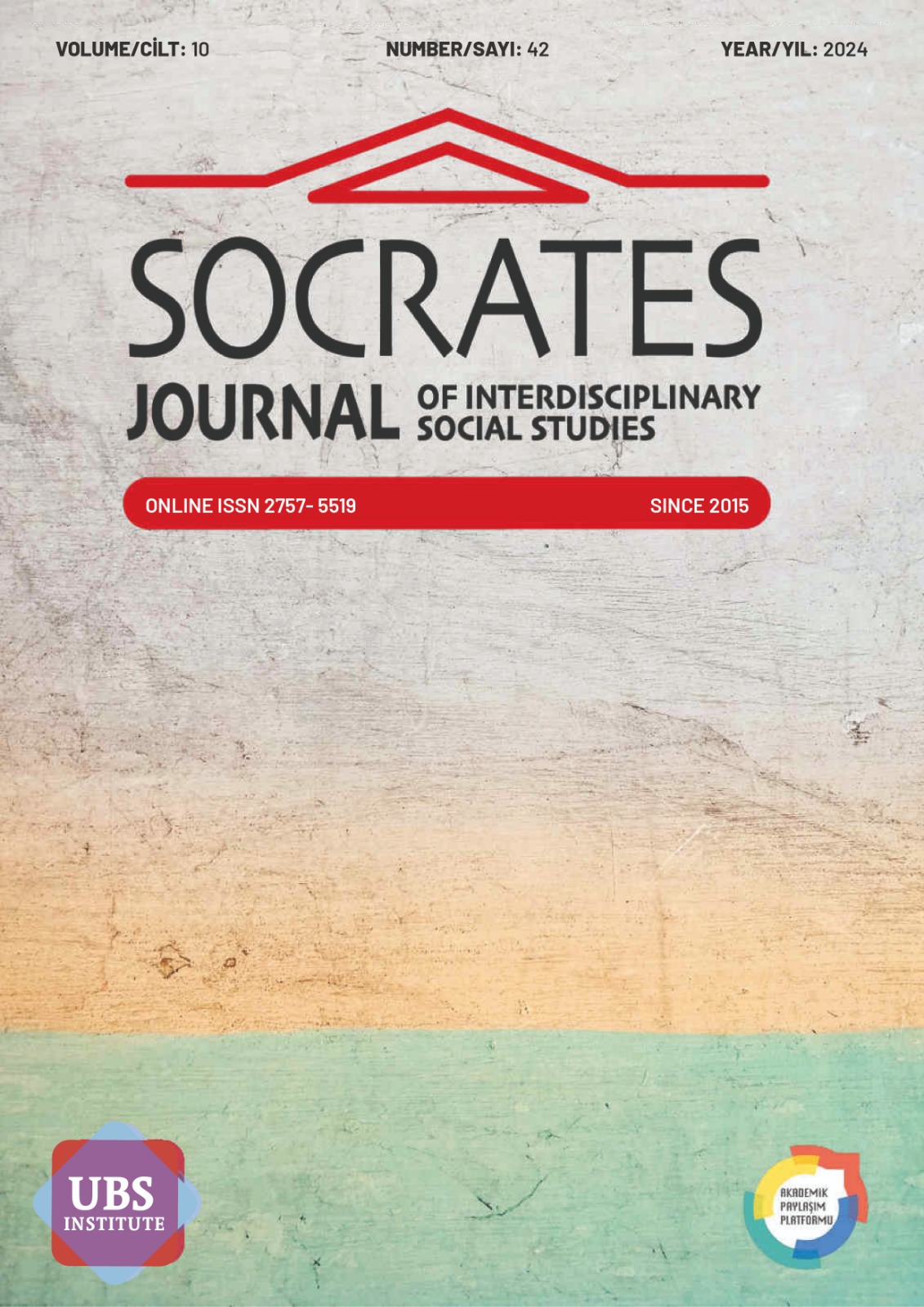SOSYAL DRAM KURAMINDAN ESTETİK DRAMA ANTROPOLOJİK BİR YAKLAŞIM: AYNA NÖRONLAR
AN ANTHROPOLOGICAL APPROACH TO AESTHETIC DRAMA FROM SOCIAL DRAMA THEORY: MIRROR NEURONS
DOI:
https://doi.org/10.5281/zenodo.11571684Anahtar Kelimeler:
sosyal dram kuramı, estetik dram, ayna nöronlar, ritüel, oyunÖzet
Bu makalede sosyal drama kuramı ile estetik dram arasındaki etkileşim araştırılmıştır. Toplumların yaşam biçimini açıklayan sosyal dram kuramı antropolog Victor Turner’ın buluşudur. Turner’ın saptamasına göre sosyal dramalar yaşamın değişim noktalarındaki eşik süreçlerine odaklanır. Yaşamı yöneten normlar tehlikeye girdiğinde toplumda kriz çıkar. Kriz önlemezse derinleşerek çatışma oluşturur. Oluşan çatışmayı çözmenin tek yolu, ritüeller olarak isimlendirilen telafi mekanizmalarıdır. Sosyal dramalardaki telafi mekanizmalarını ritüeller oluştururken estetik dramdaki telafi mekanizmalarını oyun oluşur. Bu noktada sosyal dramalarla estetik dram arasında bir analoji gözlenir. Her iki telafi mekanizması da çatışma sürecinde oluşur. Oyunda çatışmanın bitirilmesi için pek çok çözüm yolu aranır. Bu arayış toplumun birer üyesi olan seyircilerin çatışma durumunu oluşturan problem üzerine düşünmesini sağlar. Böylelikle toplum izledikleri oyun aracılığıyla kendi yaşantısındaki sorunları tekrar değerlendirme fırsatı kazanır ve sosyal dramalar ile estetik dram arasında geçişli bir ilişki meydana gelir. Toplumların sosyal ilişkilerindeki gelişimini sağlayan bu ilişkinin bilimsel açıklaması insan beyninde keşfedilen ayna nöronların varlığına dayanmaktadır. Zira ayna nöronları insanın doğuştan sahip olduğu taklit, öğrenme ve empati becerilerinin oluşumunu ve beynin yeni bir şeyi öğrenme sürecini bilimsel olarak açıklar. Bunun yanında ayna nöronları bilginin hafızaya alınması ve geliştirilmesinde rol oynar. Neticesinde sosyal dramlar ile estetik dram arasındaki etkileşimin ayna nöronların varlığıyla açıklanabilmesi yaşam sanat arasındaki ilişkiyi bilimsel boyutuyla kavrayabilmek için aydınlatıcıdır.
Referanslar
Arbib, M. A. (2005). From monkey-like action recognition to human language: An evolutionary framework for neurolinguistics. Behav Brain Sci., 28(2), 105-124. 10.1017/s0140525x05000038. https://sci-hub.se/10.1017/s0140525x05000038
Ball, D. Dramaturji çalışması bir oyun metni nasıl okunmalı?. (Çev.: Yasemin Burcu Şeyben). https://betikkonagi.files.wordpress.com/2018/01/ball-dramaturji-calismasi-oyun-okuma.pdf.
Carlson, M. (2013). Performans: eleştirel bir giriş. (Çev.: B. Güçbilmez). Ankara: Dost. (Orijinal çalışma basım tarihi: 1996)
Corrado, S. & Giacomo, R. (2019). Beyindeki aynalar. (Çev.: D. Keleş). İstanbul: Alfa bilim. (Orijinal çalışma basım tarihi: 2006)
Çobanoğlu, Ö. (2000). Halkbilimi kuramları ve araştırma yöntemleri tarihine giriş. Ankara: Akçağ.
Farina, E., Borgnis, F., Pozzo, T. (2020). Mirror neurons and their relationship with neurodegenerative disorders. J Neurosci Res., 98(6), 1070-1094. doi: 10.1002/jnr.24579. https://sci-hub.se/10.1002/jnr.24579
Freytag, G (2012). Freytag’s technique of drama, Leipzig: Forgotten Books.
Giacomo, R. & Laila, C. (2004) The mirror-neuron system. Annual review of neuroscience. 27(1), 169-192. https://sci-hub.se/https://doi.org/10.1146/annurev.neuro.27.070203.144230
Giddens, A. (2008). Sosyoloji. (Çev.: Cemal Güzel). İstanbul: Kırmızı.
Günay, U. (1995). Ritüeller ve hıdrellez. Milli Folklor Dergisi, 4(26), 2-3. https://www.millifolklor.com/PdfViewer.aspx?Sayi=26&Sayfa=1
Hage, S. R. (2018). Auditory and audio-vocal responses of single neurons in the monkey ventral premotor cortex. Hear Res. (366), 82-89. https://sci-hub.se/https://doi.org/10.1016/j.heares.2018.03.019
Keysers, C. (2019). Empatik beyin. (Çev. Ayber Eper). İstanbul: Alfa Bilim. (Orijinal çalışma basım tarihi: 2011)
Morris, B. (2004). Din üzerine antropolojik düşünceler: bir giriş metni. (Çev.: Tayfur Atay). Ankara: İmge.
Sağlam, T. (2008). Ritüel, performans, drama. 13. Uluslararası Eğitimde Drama Kongresi Bildiri Kitapçığı, Ankara: SMG.
Turner, V. (1968). Schism and continuity in an African society. Manchester: Manchester University.
Turner, V. (1982). From ritual to theatre: the human seriousness of play. USA: PAS.
Turner L. B. (Eds.). (1985). Process, system and symbol: a new anthropological synthesis, on the edge of the bush: anthropology as experience. Arizona: The University of Arizona Pres.
İndir
Yayınlanmış
Nasıl Atıf Yapılır
Sayı
Bölüm
Lisans
Telif Hakkı (c) 2024 Socrates Journal of Interdisciplinary Social Studies

Bu çalışma Creative Commons Attribution 4.0 International License ile lisanslanmıştır.


